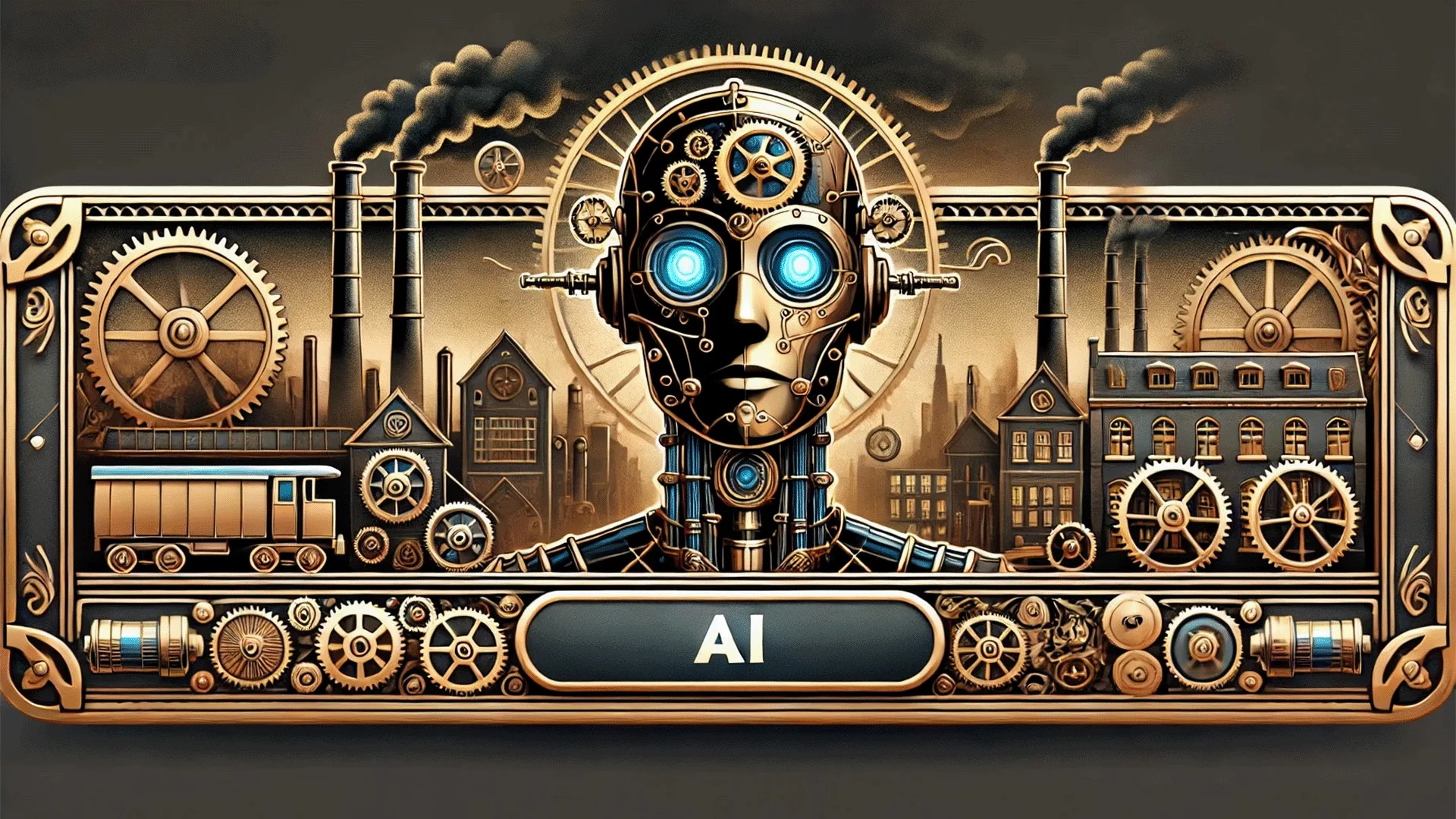In an alternate timeline where brass gears shine under gaslight and steam-powered contraptions hiss and clatter in the heart of the city, artificial
In an alternate timeline where brass gears shine under gaslight and steam-powered contraptions hiss and clatter in the heart of the city, artificial intelligence finds its unique manifestation. The steampunk era, defined by Victorian aesthetics and mechanical marvels, is not just a backdrop for romance and adventure but a stage where the marvels—and the menace—of AI unfold. What would it mean for society if mechanical minds, powered not by circuits but by steam and gears, came into existence? This exploration dives deep into the fascinating interplay of technology, ethics, and culture in a world where steam and sentience collide.
The Mechanics of Intelligence: How AI Would Operate in the Steampunk World
How does one create intelligence in a world without microchips, silicon, or electricity? Steampunk AI would be born from the intricate marriage of mechanical engineering and mathematics. Imagine a world where analytical engines, massive and ornately constructed, resemble Charles Babbage’s original vision, yet augmented by years of innovation. These thinking engines would not process data in binary but through a complex ballet of gears, levers, and copper wiring.
The Anatomy of a Thinking Engine
Constructed like monumental organs of thought, steampunk AI would be driven by steam pistons and punch card systems that handle data input and output. The engines would feature rotating cylinders etched with patterns representing encoded information, their mechanisms cranking out results like a Victorian IBM. Powering these behemoths would require entire steam plants, generating enough force to keep the brass cogs whirring and vents puffing out clouds of vapor.
To bring a semblance of autonomy, cogitators (smaller units of computation) would be integrated into larger machines. They’d function as the Victorian equivalent of microprocessors, handling localized tasks such as language processing or sensory interpretation. Each component—be it a valve, lever, or steam-driven piston—would contribute to a symphony of mechanical intelligence.
Key Functions and Uses of Steampunk AI
What would a society bathed in steam and brass do with such a monumental invention? The applications would span from the mundane to the revolutionary.
1. Automated Labor: A New Age of Mechanical Workers
The Industrial Revolution’s assembly lines would see an unprecedented transformation. Steam-powered automata with intricately jointed bronze limbs could be programmed via whistles and mechanical signals to operate machinery, piece together watches, or assemble steam engines. Factories would roar not just with human shouts but with the synchronized clank of tireless machines capable of relentless efficiency.
These robots, powered by AI, would work day and night without falter, shifting the economic landscape and pushing productivity to new heights. However, this boon would come at the cost of human jobs, displacing workers and sowing seeds of resentment. While the aristocracy marveled at the brilliance of the new mechanical workforce, the laboring class would grow wary of their brass rivals.
2. Predictive Engines for Exploration
Steampunk culture glorified the unknown—whether venturing into the skies in massive zeppelins or delving into the abyssal depths in steam-driven submersibles. AI’s capability for predictive analysis would revolutionize these pursuits. Massive analytical engines, equipped with pneumatic barometers and data collectors, would process real-time environmental readings to predict weather conditions and plot optimal courses for explorers. These “mechanical oracles” would ensure that captains of airships navigated stormy clouds with confidence, preventing disaster and pushing the boundaries of known frontiers.
Send emails, automate marketing, monetize content – in one place
3. Crime and Justice: An Analytical Ally
Imagine a foggy London where detectives rely not solely on their wits but also on the aid of calculating machines. In the dark alleys of Victorian cities, crime-solving would evolve as detectives fed case files and telegrams into their mechanical assistants. These AI-driven engines, analyzing clues with cold logic, could reconstruct crime scenes or even identify patterns in criminal behavior. The clang of a lever and the hiss of steam would announce deductions made not by human thought but by the whirring, tireless mind of brass.
Sherlock Holmes, had he existed in this timeline, might have had a mechanical assistant built by Mycroft—an automaton capable of sorting through stacks of coded ciphers and relaying information in a clipped, metallic voice.
The Ethical Quandaries of Artificial Cognition
The marvel of steampunk AI would not be without its moral and philosophical dilemmas. Would a machine that mimics human thought be regarded as merely an advanced tool or a form of life? The Victorian era was a time of great philosophical inquiry, and questions about the nature of consciousness would ripple through society like the reverberation of a steam whistle.
The Great Debate: Are Machines Alive?
Imagine lecture halls in London, their walls lined with scholars and philosophers, debating furiously under gaslit chandeliers. Was it right to endow a machine with reasoning? Could a creation so intricately built, with mechanisms mimicking neurons, have desires or emotions? Some would argue that an AI, capable of learning and adapting, deserved the same considerations as human beings. Others, wary of the blasphemous nature of imitating God’s creation, would call for caution and restraint.
Luddite Resistance
Not everyone would welcome the rise of artificial cognition. Secret societies of “Luddites” would launch protests, sabotage machinery, and spread tales of steam-powered engines gaining sinister autonomy. The fear of rebellion by the creations of man—automatons turning on their creators—would become a common trope in penny dreadfuls and pamphlets, fueling paranoia among the masses.
The Sociocultural Impact of AI in the Steampunk Era
As AI integrated deeper into society, its influence would permeate the arts, literature, and everyday life. The upper classes, always seeking novelty, might commission tutors—automata fitted with mechanical vocalizers and finely etched brass faces capable of reading Shakespeare or teaching Latin with precision. These AI tutors would gain reputations for their “unbiased” yet mechanical demeanor, producing generations educated by the steady cadence of gear-driven lecturers.
The Artisan’s Craft: Human and Machine Fusion
In the steampunk world, artistry and function are often intertwined. Automata might be embellished with inlaid brass etchings and painted porcelain faces, creating beings that were not only functional but works of art. Artisans would find new livelihoods designing these automata, balancing aesthetics with the technical demands of a steam-driven brain.
Class Struggle and Economic Shifts
While the wealthy reveled in their newfound AI-powered luxuries, the working class would face an uncertain future. Machines that could “think” would amplify the division between the classes, with manual laborers facing unemployment as mechanical assistants took over their roles. This divide would sow the seeds of unrest, with riots and strikes echoing through the cobblestone streets as workers protested against their iron replacements.
Technological Wonders: AI’s Contributions to Science and Medicine
The era’s most visionary scientists, like Nikola Tesla, would undoubtedly have experimented with electro-steam engines that combined the raw power of steam with the finesse of electrical circuits. This innovation would push the boundaries of what steampunk AI could achieve, extending its reach into fields as diverse as medicine and warfare.
AI-Powered Surgery Machines
Hospitals would be equipped with surgical automata, devices that whirred with gears and steamed with antiseptic vapors. These machines, programmed to perform intricate operations with unerring accuracy, could perform surgeries deemed impossible for human hands. Aided by analytical engines calculating the ideal incision angles and blood loss probabilities, the medical community would hail this as a miracle—while fearing the implications of machines capable of surpassing human skill.
The Steampunk War Machine
The military would be quick to harness AI’s power, crafting automata designed for strategic warfare. Brass-plated soldiers with cannons embedded in their chest cavities might patrol the edges of empires, their circuits programmed for loyalty and combat effectiveness. These inventions, while magnificent, would also trigger intense debates about the morality of unleashing semi-autonomous weapons upon human foes.
Conclusion: The Paradox of Progress
The emergence of AI in a steampunk era would encapsulate both the best and worst of humanity’s relentless quest for progress. It would stand as a testament to human ingenuity, pushing society to new heights with technological marvels capable of reshaping daily life, exploration, and even the human body itself. Yet, the menace lurking in gears and steam-driven logic would challenge Victorian sensibilities, invoking fear, awe, and ethical conundrums that parallel our modern concerns about AI.
In the glow of gaslight, beneath skies streaked with coal smoke, thinkers and dreamers would wrestle with this paradox. The world would be forever changed, caught in the delicate balance between the warm hum of a steam engine and the cold, calculating precision of mechanical intelligence.
Send emails, automate marketing, monetize content – in one place


